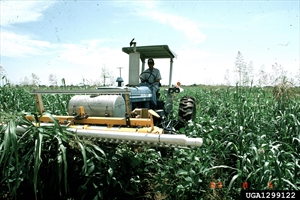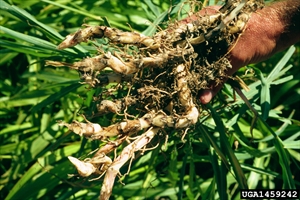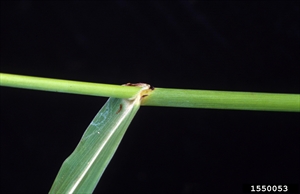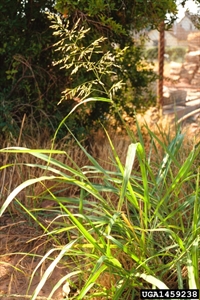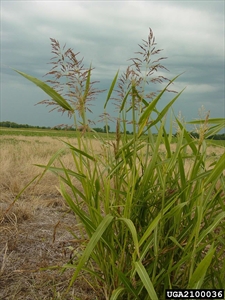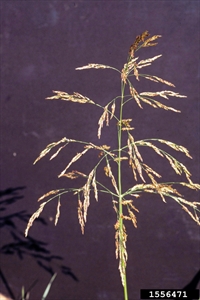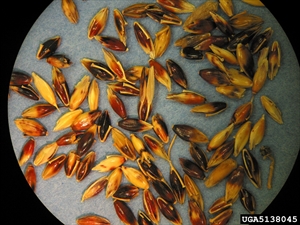Johnson grass. It is also known as Aleppo grass, false guinea grass.
Pacific Pests, Pathogens and Weeds - Online edition
Pacific Pests, Pathogens & Weeds
Johnson grass (487)
Sorghum halepense; previously known as Andropogon halepensis, and Holcus halepensis. It is a member of the Poaceae.
Asia, Africa, North, South and Central America, the Caribbean, Europe, Oceania. It is recorded from Australia, Cook Islands, Federated States of Micronesia, Fiji, French Polynesia, Guam, Marshall Islands, New Caledonia, New Zealand, Northern Mariana Islands, Palau, Papua New Guinea, Samoa. Solomon Islands, Tonga, and Vanuatu. Native range uncertain; possibly Mediterranean, including North Africa and South Asia.
Johnson grass has become one of the most invasive weeds worldwide, capable of forming dense stands (Photo 1). It invades open cultivated fields, e.g., cotton, maize, soybean, and sugarcane (Photo 2), and also forms dense infestations in wastelands, natural vegetation, and on roadsides. Johnson grass occurs throughout the tropics, but is best adapted to the sub-tropics, especially where summer rainfall provides conditions for rapid growth.
A perennial grass up to 3 m, with numerous upright flowering stems growing from thick underground rhizomes (Photo 3). Leaves up to 50 cm, 2 cm wide, hairless, with a prominent white midrib, and a 1-3 mm long membrane (ligule) with hairs at the junction of leaf blade and stem (Photo 4&5). Flowering stems, unbranched, sometimes with prop roots, green to purplish (Photos 6&7). The seedhead, 10-35 cm long, is composed of central stem, branches, and branchlets bearing spikelets in pairs or triplets at their ends (Photo 8). Only one of the pair or the triplet bears seed. Seeds are reddish-brown oval, 3-4 mm, finely lined (Photo 9.
Spread occurs by rhizomes over short distances, with seeds providing both local and long distance spread. There are a number of features of seeds that make them important in spread and survival: Johnson grass is self-fertile, produces seed in large amounts, which have a dormancy period that breaks slowly, retaining viability in soil for at least 7 years, and they pass undamaged through animal intestines. The main methods of spread by seeds are: on the wind, over-ground and in irrigation water, as a contaminant of seed lots, with fodder and on vehicles.
Survival through adverse conditions is by seeds in the soil, and the ability of rhizomes to regrow after fires and flooding.
The grass causes substantial crop losses from its ability to invade agricultural land rapidly, helped by production of chemicals which inhibit growth of competitors (allelopathy). It also harbours pests and diseases, e.g., the sorghum midge, Contarinia sorghicola (see Fact Sheet no. 336), and the aphid-transmitted Sugarcane mosaic virus, which causes diseases in sugarcane, maize and sorghum. The grass is also a host of fungal diseases, e.g., northern leaf blight of maize (Setosphaeria turcica), (see Fact Sheet no. 226), bacterial diseases, e.g., Sorghum streaky spot (Xanthomonas vasicola pv. holcicola) (see Fact Sheet no. 73).
It is also toxic to livestock, containing chemicals called glycosides which may increase in concentration when the grass is growing rapidly after drought. When consumed by cattle or sheep, hydrogen cyanide is released inside the animals. Land with large infestations of Johnson grass increases its fire risk. Its pollen is a moderate allergen.
Johnson grass is an important fodder grass in the sub-tropics; it has a similar protein content to alfalfa (lucerne) and a similar quality to that of other fodder grasses. It is used to control soil erosion because of its extension root system.
BIOSECURITY
There is a high risk of introduction and spread of this grass; introductions may occur intentionally as seeds and rhizomes to established the plant as a forage or fodder crop, or accidentally as a contaminant of seed lots or on vehicles. Countries not yet infested by Johnson grass should consider all likely pathways for entry, and apply quarantine measures accordingly. Particular attention should be paid to the chance that consignments of maize and sorghum seed could be contaminated with seed of Johnson grass.
Sorghum halepense is on the Global Invasive Species Database (2021) of information on alien and invasive species that negatively impact biodiversity, managed by the Invasive Species Specialist Group of the IUCN Species Survival Commission: (http://www.iucngisd.org/gisd/speciesname/Sorghum+halepense).
BIOCONTROL
Biological control methods have not been successful against the weed.
CULTURAL CONTROL
Johnson grass is difficult to control, and IPM programs are necessary which integrate measures such as those below, and include the use of herbicides.
- Physical & Mechanical:
- Pull-out plants by hand, making sure to include the rhizome. Collect and burn, do not leave plants or plant parts in contact with soil. A method recommended for small infestations.
- Use clear polyethylene sheets to solarise soil; repeat treatment as needed.
- Plough infestations; note, regeneration is likely to occur from rhizomes and tillage needs to be done repeatedly, at 2-weekly intervals to achieve control.
- Heavily graze fields over 2 years to deplete reserves in the rhizomes.
- Mow areas infested with the grass; a method similar in effect to grazing with cattle.
- Keep geese to eat young shoots; a method with limitations as mature plants are not eaten.
- Use fire, but follow up with herbicide as spouts are likely from underground rhizomes.
- Hygiene:
- Treat vehicles and farm machinery. If moving from areas where the weed occurs to those weed-free, wash to remove soil. This is equally important if the machinery is being imported into a country or moved within a country.
- Where the weed is already present, ensure seeds are not carried on clothes between infested and 'clean' areas.
- Quarantine livestock for at least 1 week between moving them from Siam weed-infested areas.
- Do not move soil, sand or gravel from infested to Siam weed-free areas.
IPM programs combining grazing, mowing, cultivation, crop rotation, use of competing crops and chemical control have been used to manage this weed.
CHEMICAL CONTROL
Apply herbicides, preferably before flowering. Several herbicides are registered in Australia, including: butroxydim; clethodim; glufosinate-ammonium; glyphosate; haloxyfop; imazapyr; oxyfluorfen; quizalofop-p-ethyl; trifluralin; diquat + paraquat.
--------------------
Note, EU approval to use glyphosate ends in December 2022; its use after that date is under discussion.
____________________
When using a pesticide, always wear protective clothing and follow the instructions on the product label, such as dosage, timing of application, and pre-harvest interval. Recommendations will vary with the crop and system of cultivation. Expert advice on the most appropriate herbicides to use should always be sought from local agricultural authorities.
AUTHOR Grahame Jackson
Information from Sorghum halapense (L.) Pers. (2020) Weeds Australia - Profiles. Centre for Invasive Species Solutions, Department of Agriculture, Water and the Environment. Australian Government. (https://profiles.ala.org.au/opus/weeds-australia/profile/Sorghum%20halepense); and CABI (2019) Sorghum halepense (Johnson grass). Crop Protection Compendium. (https://www.cabi.org/cpc/datasheet/50624); and from Johnson grass (Sorgun halepense) (2017) NSW WeedWise. Department of Primary Industries. NSW Government. (https://weeds.dpi.nsw.gov.au/Weeds/Details/74). Photos 1&7 Charles T. Bryson, USDA, USDA Agricultural Research Service, Bugwood.org. Photo 2 John D. Byrd, Mississippi State University, Bugwood.org. Photo 3&6 Steve Dewey, Utah State University, Bugwood.org. Photo 4 Ohio State Weed Lab , The Ohio State University, Bugwood.org. Photo 5 Karan A. Rawlins, University of Georgia, Bugwood.org. Photo 8 John Cardina, The Ohio State University, Bugwood.org. Photo 9 Lynn Sosnoskie, University of Georgia, Bugwood.org.
Produced with support from the Australian Centre for International Agricultural Research under project HORT/2016/185: Responding to emerging pest and disease threats to horticulture in the Pacific islands, implemented by the University of Queensland and the Secretariat of the Pacific Community.
